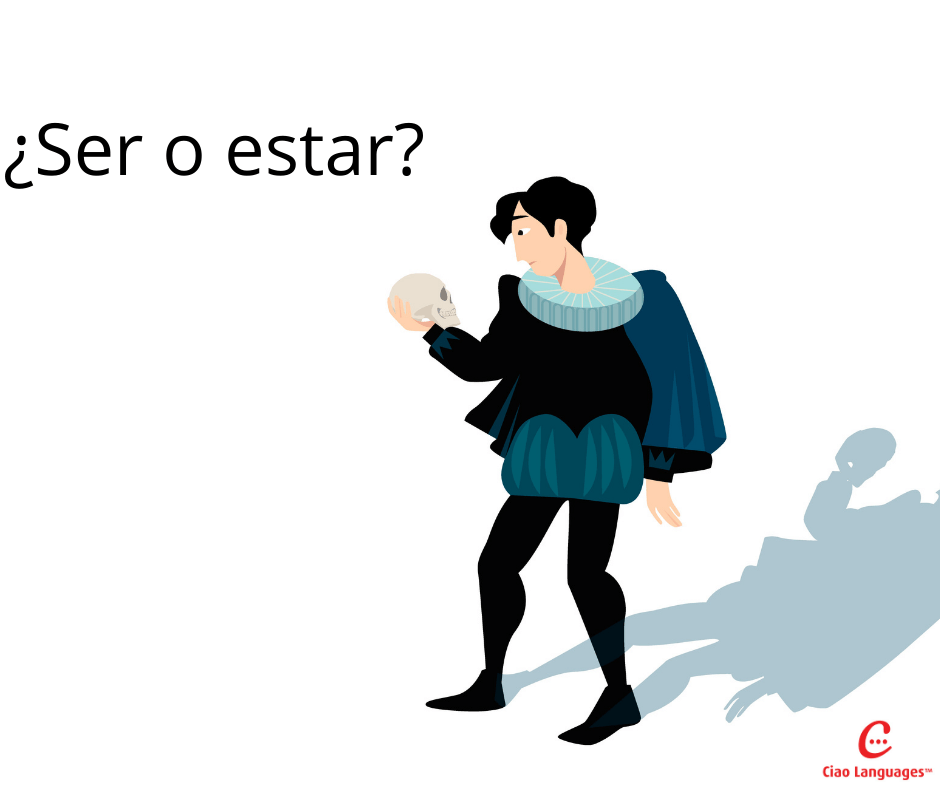When do you say “Ser” and when do you say “Estar”?
In English we ask ourselves, “To be or not to be?”
In Spanish we essentially ask ourselves, “¿Ser o estar?” – Which in English translates as “To be or to be“! So, what gives?
The answer to that question largely depends on the context.
We use “ser” if we are referring to a permanent state, whereas “estar” is used for temporary states. Let’s take a closer look at the difference between the two forms of “to be”:
“Ser” – Permanent State
Ser
Facts – El cielo es azul (The sky is blue).
Time – Son las cuatro de la tarde (It’s four p.m.)
Personal characteristics – alto (tall), bajo (short), amable (kind), amigable (friendly), rico (rich)
Nationality – Americano/a (American), Español/a (Spanish), Colombiano/a (Colombian), Mexicano/a (Mexican), Peruano/a (Peruvian)
Occupation – doctor/a (doctor), abogado/a (lawyer) contador/a (accountant), profesor/a (teacher), banquero/a (banker)
Relationships – compañeros/as (partners), marido/a (spouses), hermanos (brothers), hermanas (sisters), primos/as (cousins)
Examples with Ser
The world is round. (Fact)
El mundo es redondo.
Juan is tall. (Personal characteristic)
Juan es alto.
Today is Tuesday. (Time)
Hoy es martes.
I am Colombian. (Nationality)
Yo soy Colombiano.
You are a lawyer. (Occupation)
Tú eres abogado.
They are brothers. (Relationship)
Ellos son hermanos.
She is rich. (Personal chacateristic)
Ella es rica.
He is American. (Nationality)
El es Americano.
We are teachers. (Occupation)
Nosotros somos profesores.
You’ll notice that all the situations above describe permanent states, and therefore “ser” is the appropriate form. The verb “to be” is then conjugated depending on the subject.
“Estar” – Temporary State
Estar
Estar, on the other hand, is used to describe a temporary state or status. For example, if you want to say “He is angry,” you would say, “Él está enfadado.” Contrarily, let’s say you want to say, “He is an angry person,” you would say, “Es una persona enojada.”
Emotions/Conditions – feliz (happy), triste (sad), enfadado/a (angry), cansado/a (tired), emocionado/a (excited)
Locations/Positions – en el parque (in the park), en la playa (at the beach), en Miami (in Miami), en cine (at the movies), en el restaurante (in the restaurant)
Now let’s have a look at how these look in sentences:
Examples with Estar
I am tired. (Emotion)
Yo estoy cansado.
He is sad. (Emotion)
El está triste.
She is angry. (Emotion)
Ella está enojada.
They are in the park. (Location)
Ellos están en el parque.
We are in the restaurant. (Location)
Nosotros estamos en el restaurante.
You are happy. (Emotion)
Tu estás feliz.
Here, all the situations are temporary and therefore “estar” is the verb being conjugated.
I think you’re catching on, but let’s make sure. It’s time to put these into practice. Conjugate the following verbs using the correct form of either ser or estar.
He is angry.
El _____________ enojado.
If you said “está”, you are correct. Being angry is a temporary state, so we use the verb “estar.’
Let’s try another one:
She is friendly.
Ella ___________ amigable.
Being a friendly person is a permanent state, so “ser” is the base verb and “es” is the correct answer.
Now that you’re quickly becoming an expert, let’s just do a couple more:
They are cousins.
Ellos ______________ primos.
Once again, we are discussing a permanent state of being cousins. Therefore, “ser” is the correct base verb and “son” is the correct conjugation.
I am in Miami.
Yo ________________ en Miami.
Let’s Check to Make Sure You Get it!
I think you’re catching on, but let’s make sure. It’s time to put these into practice. Conjugate the following verbs using the correct form of either ser or estar.
He is angry.
El _____________ enojado.
If you said “está”, you are correct. Being angry is a temporary state, so we use the verb “estar.’
Let’s try another one:
She is friendly.
Ella ___________ amigable.
Being a friendly person is a permanent state, so “ser” is the base verb and “es” is the correct answer.
Now that you’re quickly becoming an expert, let’s just do a couple more:
They are cousins.
Ellos ______________ primos.
Once again, we are discussing a permanent state of being cousins. Therefore, “ser” is the correct base verb and “son” is the correct conjugation.
I am in Miami.
Yo ________________ en Miami.
I know, you probably wish you were in Miami right now – but in this situation you are. However, being located anywhere is always just temporary, and so we use “estoy” to conjugate “estar.”
So now I ask you again – “To be or to be?” The answer is simple. Just ask yourself if the situation is permanent or temporary and you’ll always know whether to use ser or estar.
If that sounds simple, it’s because it is. Ciao Languages is here to simplify your language-learning experience, one rule at a time.

Quote Request

Already speak a bit of Spanish? Perhaps you’d like to try out our Spanish language level test. It’s just thirty questions, and you can opt out after every five questions. The results are immediate! Have fun!
Spanish Langauge Level Test
“Ser” and “Estar” – Conjugations
Conjugation of the verb “Ser”
Yo soy (I am)
Tú eres (You are – informal)
Él, ella es (He/She is)
Nosostros somos (We are)
Vosostros sois (You are – Plural, Castillian Spanish)
Ustedes sono (You are – Plural, Latin American Spanish)
Ellos/ellas son (They are plural masculine/plural feminine)
Conjugation of the verb “Estar”
Yo etsoy (I am)
Tú estás (You are – informal)
Él, ella está (He/She is)
Nosostros estamos (We are)
Vosostros estáis (You are – Plural, Castillian Spanish)
Ustedes están (You are – Plural, Latin American Spanish)
Ellos/ellas están (They are plural masculine/plural feminine)

